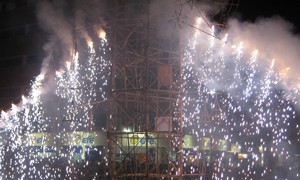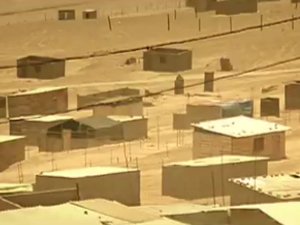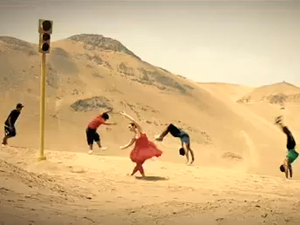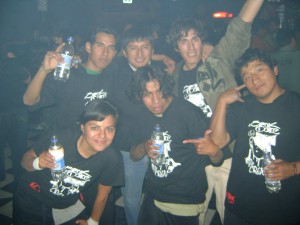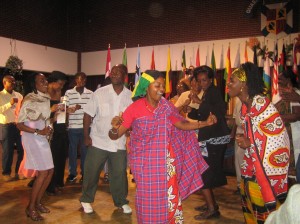I spent my Christmas and New Year’s Huancaino-style with my Peruvian family and the rest of my vacation days travelling across the country from the beaches on the coast to jungle of the rainforest.
First stop before Christmas – Lima. As winter and the rainy season began in Huancayo (and the rest of the sierra), it was nice to escape to the summer that was starting in Lima and the coast of Peru. I managed to fit in all things tourist-y in Peru’s capital in a week:
- We suntanned, climbed rock formations, hunted lizards, and jumped into the waves at a serene beach a few hours away from the big city – “The Sleeping Lion” they call it because of the shape of the rock castle that borders the sand.
- We shopped in downtown Lima, walking up and down the famous street “Jirón de La Unión” that reaches from the main plaza to the government’s palace, drinking cremoladas (slushies you can’t find in Huancayo) and purchasing all the manta bags in sight – I think I have a collection of over 7 purses now, haha! On the last day we were in Lima, we even caught the beginning of Peru’s yearly telethon at the government’s palace with all the country’s famous celebrities performing to raise money for needy children at Christmastime.
- I was denied at some hostels because I forgot my passport and they wouldn’t accept my BC driver’s license. =P
- I finally had some really good snacks and meals – soft cinnamon buns with extra melting cream, real chunky cookies, Tony Roma’s ribs, and sushi (all also non-existent in Huancayo – been feeling deprived =P).
- We visited Parque de Las Leyendas (Park of Legends), which was like a themed zoo. There were native animals from all corners of Peru and some not from here (my favourites were the sea lions =D).
- We also visited La Casa de Papá Noel (Santa Claus’ house) at the Parque de La Reserva where there are light and water shows in the evenings. Actually, it was more like we saw Santa Claus’ house from the outside because the line-up was 3 hours long.
Christmastime was very family-oriented and although the holidays make me sentimental and a little homesick, my Peruvian family made me feel so at home here in Huancayo. My Peruvian mommy cooked a special dinner of pork chop and chorizo then we opened presents at midnight of Christmas Eve – all the presents were set up in a circle and we rolled the dice to choose which present would be opened next.
On Christmas day, we were off to the rainforest to the towns of La Merced and Pichanaki. Most days we visited different swimming pools, chicken-fighting, trying to teach myself how to dive headfirst (a failure), and playing water polo. There was one afternoon we visited a pair of famous waterfalls – Bayoz and Velo de Novia (bride’s veil) – swimming underneath the falls themselves. On the way back to Huancayo, we visited some other tourist sites in the sierra including Huagapo (apparently, one of the deepest caves in the world). We didn’t walk in very far because I had sandals on, but what we did walk into was in complete darkness. Our guide used his flashlight so we could find our way, all of us holding hands, and so that we could see the bats and all the stalagmites and stalactites that have naturally formed themselves into interesting shapes (like a seated horse and a roaring lion).
New Year’s Eve was a fiasco. A whole bunch of relatives came over for a huge dinner and nonstop dancing (mostly huayno – music native to the sierra). The theme is all yellow, which is supposed to bring good luck – yellow “2009” glasses, yellow “Feliz Año” hats, yellow clothes, yellow underwear. Come midnight, there are a series of rituals that I wouldn’t have remembered if they weren’t all telling me what to do – yellow confetti is thrown, we greet each person at the party with a hug and “Feliz Año,” we put lentils in our wallets for prosperity, we eat 12 grapes and make a wish on each one of them, then of course – more dancing. I went to bed at the late hour of 1:30am and when I woke up at 9:30am that morning, the music was still pounding downstairs and people were still dancing!
Note re: living fungal parasite. So they were mites that caused the little bug bites all over my body every evening – I just had to use an anti-scabies cream then wash my sheets and all was well. As for the rash – I had a biopsy and from the lab results it was diagnosed as chronic discoid lupus (which, to me, actually sounds sorta cool). I’m waiting for the pictures of the lab results so that I can bring them to Canada and get a second opinion. The cream he prescribed for lupus didn’t make the rash any better and he’s suggesting a corticoid injection, which I would rather have done in Canada. =P



